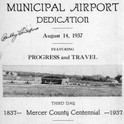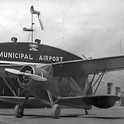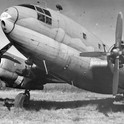Then and Now
Municipal Airport
Linda Hill Mann
William B. Honaker (1858-1927) and others agreed to donate 54 acres and 8 ½ acres respectively on Glady’s Fork of Brush Creek, immediately beyond Princeton’s corporate limits, to A. I. Bratton, Trustee. The land was to be used to establish a Fitting School as a branch of Emory and Henry College. A Fitting School was a private preparatory school for young men and women wanting to enter college. Citizens donated $21,021 toward the cost of starting the school.
The plans for the Fitting School fizzled and in 1933 and 1934 interest for the land to be used to build an airport grew. There was legal wrangling with the heirs of William B. Honaker who died in 1927. The heirs thought they were entitled to the return of the property since it was not being used for the original purpose. The City won, and the Bank of Princeton bought the contested land at a delinquent tax sale.
The purchase price was $2,950 at auction, enough to pay a judgment against the property by an architect who had drawn up plans for the school, and to cover the taxes, penalties, interest and costs but nothing remaining for the donors or equity owners. The bank immediately turned the property over to the City of Princeton for construction of the airport.
In 1937 the City of Princeton built the Princeton Municipal Airport using Work Progress Administration/Works Projects Administration (WPA) funds. The WPA was an agency that employed millions of the unemployed during the depression to carry out public works projects, including the construction of public buildings and roads. It was part of President Franklin D. Roosevelt’s Second New Deal.
The airport was formally dedicated on August 14, 1937, during the Mercer County Centennial Celebration 1837-1937.
George Edwin Lynch (1920-1994) his wife, Daisy Pifer Lynch (1913-2012) and James H. Tolley (1900-1960), leased the Princeton Municipal Airport. George ran the airport from 1939-1953.
The airport served as a training spot for 2,000 flying students of Concord College during World War II in connection with the Civilian Pilot Training Program. James Tolley operated the program. He also operated the Hinton-Alderson Airport. He was a commercial flight examiner with the Federal Aviation Agency until 1958.
George Lynch was chief pilot for Greenbrier Airlines. He was one of the earliest aviators in the area, receiving his commercial rating in 1936. He held an Air Transport Rating, the highest in aviation.
Daisy Lynch was bookkeeper for the Lynch-Tolley Flying Service that was operated out of the Princeton Municipal Airport. After leaving the airport she went on to be the manager of the limousine service for the Greenbrier until her retirement. The Lynches gave up the lease of the Princeton Municipal Airport stating that the City of Princeton kept threatening not to renew the lease and to build apartments on the site.
The airport had one 2,000-foot northwest/southwest shale runway with two hangars on the 36 acre site. By 1951-52 the runway was described as a strip with grass and some shale. George Lynch had previously flown an old World War II C-46 bomber into the airport. It was parked at the end of the runway. The Boy Scouts owned it, painted it red and green, and used it as their clubhouse.
By 1955 Herbert A. ‘Buddy’ Sessler and Doug Barger were running the Princeton Flying Service out of the airport. They offered lessons to anyone interested in learning to fly. One of those persons in the early 1960s was fifteen year old Garland Elmore. He described his experience this way:
A boy growing up in Athens during our years had a lot to look forward to as his 16th birthday approached. Near the top of the list was the prospect of a new driver’s license and newfound independence that comes with access to the family car. Another dream for me was to learn how to fly. The Federal Communications Commission permitted training at a very young age and a kid could fly solo at sixteen and, with a little experience, get his private pilot’s license by seventeen. I read a lot about what to expect in training and concluded that’s what I wanted to do.
Princeton Municipal Airport offered lessons and my dad provided $12 for a lesson. On the first day, I anticipated a half-hour of “ground school,” which I had read about, to be followed subsequently by work with a flight simulator. But when my dad and I arrived at the airport to meet the instructor, things took an unexpected turn. The instructor said there was no need for the paper and pencil I brought because the “only way to learn to fly is to fly.” He then introduced an early vintage two-seater plane, with a trailing rear wheel, and an engine that had to be started by manually turning the propeller. We went through the inspection and safety check together. I was surprised (again) as we climbed into the plane. I naturally went to the rear seat; this was a two-seater plane with one seat in front of the other. The instructor said, “no, no, no, both seats have joysticks and flight controls. Sit in front so you can get a feel for flying.” I was anxious, but at fifteen I did what I was told.
I recall talking with the instructor over the roar of the engine after it was started by an airport employee. There was talk about pulling back on the stick, coordinating the right and left foot pedals, adjusting the throttle to full speed for takeoff, anticipating the lift of the tail as the plane picked up speed, the eventual liftoff, and this little matter of making sure the plane cleared the fence not too far from the end of the runway. Off we went. We flew over Princeton and Athens; I tried to identify landmarks but found that to be surprisingly difficult. Surely, I would learn more about navigation in ground school, I thought. Ground school never came, but other lessons gave me some (but not enough) confidence. I never learned to solo; I needed somebody to tell me how to get back to the airport. It was a great experience though, and the Princeton Municipal Airport remains a destination with very fond memories. I'm thankful for the experience and that I didn't die by a fence in 1962.
The opening of the Mercer County Airport about 9 miles away in 1954 was the beginning of the end for the small Princeton Municipal Airport. The airport was closed about 1963. Princeton Community Hospital founded in 1970 was built where the old airport had been located.
Sources:
Obituaries of George Lynch, Daisy Lynch and James Tolley
Members.tripod.com
1984 Mercer County History book
Honaker v. City of Princeton, May 18, 1943

A Waco sport biplane in front of the Princeton Municipal Airport. (Paul Freeman photo.)
A Special Destination





